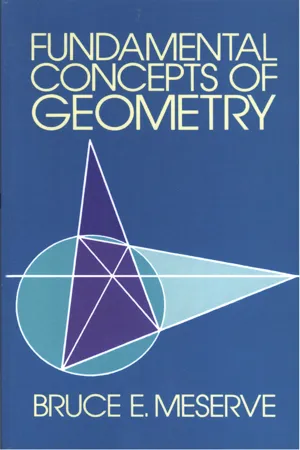![]()
CHAPTER 1
FOUNDATIONS OF GEOMETRY
The word “geometry” is derived from the Greek words for “earth measure.” Since the earth was assumed to be flat, early geometers considered measurements of line segments, angles, and other figures on a plane. Gradually, the meaning of “geometry” was extended to include the study of lines and planes in the ordinary space of solids, and the study of spaces based upon systems of coordinates, as in analytic plane geometry, where points are represented by sets of numbers (coordinates) and lines by sets of points whose coordinates satisfy linear equations. During the last century, geometry has been still further extended to include the study of abstract spaces in which points, lines, and planes may be represented in many ways. We shall be primarily concerned with the fundamental concepts of the ordinary high-school geometry — euclidean plane geometry. Our discussion of these concepts is divided into three parts: the study of the foundations of mathematics (Chapter 1), the development of euclidean plane geometry from the assumption of a few fundamental properties of points and lines (Chapters 2 through 6), and a comparison of euclidean plane geometry with some other plane geometries (Chapters 7 through 9). The treatment of the second part —the development of euclidean plane geometry — forms the core of this text and emphasizes the significance of the assumptions underlying euclidean geometry. Together, the three parts of our study enable us to develop an understanding of and appreciation for many fundamental concepts of geometry.
1–1 Logical systems. We shall consider geometries as logical systems. That is, we shall start with certain elements (points, lines, . . .) and relations (two points determine a line, . . .) and try to deduce the properties of the geometry. In other words, we shall assume certain properties and try to deduce other properties that are implied by these assumptions.
In a geometry or any other logical system, some undefined elements or terms are necessary in order to avoid a “circle” of definitions. For example, one makes little progress by defining a point to be the intersection of two distinct lines and defining a line to be the join of two distinct points. A nonmathematical example would be obtained by defining a child to be a young adult and an adult to be a full-grown child. Thus, in any geometry, some of the elements must be accepted without formal definition; all other elements may be defined in terms of these undefined elements* Similarly, in any geometry some of the relations among the elements must be accepted without formal proof. These assumed relations are often called assumptions, axioms, or postulates. Other relations, which may be proved or deduced, are called theorems.
Definitions enable us to associate names with elements and relations that may be expressed in terms of the undefined elements, postulates, previously defined elements, and previously proved relations. The postulates and definitions are combined according to the rules of logic (Sections 1–2 and 1–3) to obtain statements of properties of the geometry. Necessary and desirable properties of postulates are considered in Sections 1–4 through 1–6. Definitions should be concisely stated, should give the distinguishing characteristics of the element or relation being defined with reference to the element or relation most similar to it, should be reversible, and should not contain any new elements or relations.
A reversible statement may be expressed in the form of “if and only if.” For example, the statement: A triangle is equilateral if and only if its three sides are equal is reversible. This statement is commonly expressed as a definition: An equilateral triangle is a triangle having three equal sides. That is, we interpret the definition to mean that all equilateral triangles have three equal sides and that all triangles having three equal sides are equilateral. In other words, we usually assume that definitions are reversible.
A definition of a new term is not acceptable if it involves terms that have not been previously defined. A proof of a theorem is not acceptable if it involves relationships that have not been previously proved, postulated, or stated as assumptions in the hypothesis of the theorem. Such faulty definitions and proofs often involve “circular reasoning.” If a statement such as: A zig is a zag and its converse statement (Section 1–2): A zag is a zig are both taken as definitions, we have a circle of definitions and have not improved our understanding of either zigs or zags. In general, whenever the definitions of two elements, say A and B, are related such that the definition of A depends upon the element B and the definition of B depends upon the element A, we have an example of reasoning in a circle in setting up our definitions. Whenever the conclusion of a theorem is used as a basis for a step in the proof of the theorem, we have an example of reasoning in a circle in the proof of a theorem. To avoid such reasoning in a circle we must have undefined elements and unproved relations (postulates) among these elements. Throughout this text we shall be concerned with definitions and theorems based upon sets of undefined elements and unproved postulates.
EXERCISES
1. Discuss the reasoning in the following story:
Long ago some Christian monks heard that in a certain medieval village there lived a holy man who talked with angels. In order to verify this report the monks traveled to the village and talked with some of the local people who knew the holy man. These people repeated the story of the holy man and, when asked how they knew that he talked with angels, said that he had told them...
